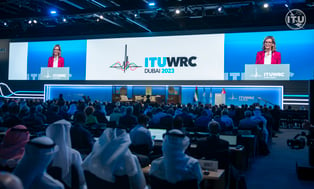

During the recent World Radiocommunication Conference 2023 (WRC-23) in Dubai, the International Telecom Union (ITU) concluded on “groundbreaking spectrum decisions that will shape the future of mobile communications”. The participating national telecom authorities agreed on a new mobile low-band spectrum (below 1 GHz) and mid-band spectrum in the 3.5 GHz and 6 GHz ranges.
The GSMA, which is a lobby organization that represents the interests of mobile network operators worldwide, clearly welcomed these outcomes that shall allow the mobile sector to plan the next wave of communications development through 5G-Advanced and beyond.
The World Radiocommunication Conference is held every four years under the auspices of the ITU (the United Nations’ specialized agency for information and communication technologies).
These treaty conferences have the power to change international agreements on the use of radio spectrum.
For mobile communication, which the ITU refers to as International Mobile Technologies (IMT), WRCs serve a role in harmonizing the spectrums. Harmonization shall help to ensure economies of scale and facilitate planning for new spectrum bands to address data growth and deliver a future of sustainable connectivity “Clearing the path for a bright digital future for billions worldwide”.
Mobile spectrum discussions at WRC-23 focused on three core ranges:
-Low-band spectrum for covering wide areas with lower population density. This makes it an important natural resource that can deliver digital equality.
-City-wide capacity which requires mid-band spectrum to deliver the main weight of connectivity requirements. The 3.5 GHz range is the birthplace of 5G and is assigned in over 80 countries already.
-On average, 2 GHz of mid-spectrum spectrum per market will be needed by 2030 to meet the demand of citizens and businesses in cities around the globe. The 6 GHz band is the only remaining mid-band spectrum currently available to respond to the data traffic growth in the 5G-Advanced era. The WRC-23 decision to harmonize the 6 GHz band in every ITU Region is a pivotal milestone, “bringing a population of billions of people into a harmonized 6 GHz mobile footprint”.
For further information, please contact Tom.Tidwell@nemko.com
(The article is based on this GSMA announcement and edited by T.Sollie)
